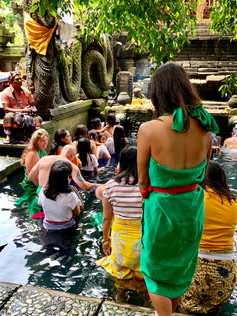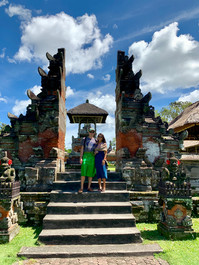Island of the Gods: Bali, Indonesia
- mkap23
- May 24, 2020
- 13 min read
We’ve been dreaming about Bali for some time now. As much as we love traveling, the constant movement and stimulation can also be exhausting. So we were looking for a place to settle down for a few weeks and recharge for the second half of our trip, and Bali was our natural choice. As we had already been to the island a little over five years ago on our honeymoon, there would be no pressure to see or do anything, making it the perfect place to take a brief travel respite. Plus, we could practice yoga with our friends and former yoga instructors, Prem and Radha, at their shala just outside of Ubud. But it’s not like we needed any reasons—Bali is simply awesome.

Why do we love Bali? It’s really no secret. After all, it attracts six million visitors each year, along with a significant number of expats who live there, believing (possibly correctly) that they have found their Eden; it was “loved” by Elizabeth Gilbert in Eat, Pray, Love; and it is consistently listed as one of the world’s top travel destinations. The Indonesian island is certainly an idyllic tropical paradise, with attractive beaches along warm ocean waters, verdant tropical rain forests, quaint rural villages, and active volcanic mountains looming over rice terraces. But having traveled throughout much of Southeast Asia over the past four months, this landscape isn’t necessarily uncommon or distinctive, so what makes Bali different?
Is it the high end tourist experience and high quality food at relatively inexpensive prices? Or because we have such great memories of our time there on our honeymoon? Is it because it reminds us of Hawaii in many ways? Or is it the thoughtful design of the homes, villages, and hotels, the connection to nature, or the healthy lifestyle?
We don’t have a specific answer, but there’s just something about Bali.
While our home for the next ten days would be in the central uplands of Ubud, we spent our first day on the Bukit Peninsula near Uluwatu, on the island’s south shore, hanging with our friends Mike, Lizette and Lily (whom we had seen a few weeks earlier in Thailand) before they headed back home to the States. Like on Ko Lanta, our time with them was mostly spent on the beach. On Bali, this meant playing at Padang Padang, a beautiful cove situated 100 feet below dramatic rocky cliffs. Unfortunately, signs of the rapid development along the southern coast were everywhere—the beach was crowded, and the water, though extremely clear, sadly had trash floating about in it. Still, that didn’t stop Mike and Mike from surfing the small-kine waves. Ultimately, about the only thing that Mike K. caught was a major sunburn, but he did have fun attempting to surf for a few hours in the warm water. After a taco lunch in Padang Padang town, which reflected a California surf vibe (Billabong and Ripcurl stores helped set the scene), and a quick trip down another steep cliff to Bingin Beach, we spent the afternoon hanging out at Mike and Lizette’s guesthouse, playing with Lily (including helping her get her first haircut—in life!), feasting on a dinner of local Lalapan Ayam (roadside cooked fried chicken with rice and spicy sambal), and drinking wine in celebration—or more likely, in mourning—of the end of their trip.
After we bid them farewell, we headed up to Ubud and checked into our AirBnB, a cute cottage in the back of a Balinese family compound. While not original, the compound still conformed to the traditional layout of a Balinese home. Upon entering a gate into a walled area, there were a number of smaller, individual, buildings: the family’s sleeping quarters, an indoor/outdoor kitchen, laundry, and a modern four room guesthouse, indicative of the major industry in Ubud. On the north side of the property, aligned to face towering Mount Agung in the distance, was an elaborate shrine comprised of stacked volcanic stone. Our cottage was tucked in the back behind this shrine, allowing us to walk through the daily life of the Balinese family that owned the home as we came and went each day. To us, the shrine looked large enough to be a public Hindu temple, but it was just for personal use for the family. It turns out that most family compounds have their own similar large offering area. It felt very elaborate and wealthy to us—imagine each family owning their own temple or church to pray in—but a local Balinese man whom we got to know told us that a temple is the first thing Balinese families build on their property as soon as they save enough money. With so many shrines and temples within every home and down every street, infusing the air with a constant aura of spirituality, it’s no wonder that Bali is known as the “Island of the Gods.”
The cottage itself was through another thatched gate that led into a little yard, with heliconias, gingers, and ti providing splashes of color against the lush green canvas. A small covered lanai provided shelter as we watched the rapturous rain fall each day (it was the tail end of rainy season, so there were daily squalls), and inside was a nice sized one-bedroom home with a simple kitchen, living room, and full dining table. When not practicing yoga, we spent much of our time reading and writing at this cute little home away from home. We also enjoyed our time in the kitchen, being able to cook fresh Indonesian tempeh or make yogurt fruit bowls for ourselves after five months of constantly eating out. It was the perfect place to slow down and recharge our traveling bones.

While our days and nights were mostly lazy affairs, our mornings were busy. On our first morning, we woke early to a steady rain, and briskly walked a few minutes to the main street to catch the “yoga shuttle” at our designated pick-up time of 6:55am. Eddie, Prem and Radha’s trusted Balinese driver and jack-of-all-trades confidant, rolled up soon thereafter, and we hopped in. Along with Amy from England, Jens from Germany (who lives in Egypt), and Angie from Bolivia, we headed north through the gorgeous countryside to the Ashtanga Yoga Research Center, which Prem and Radha built and opened about ten years ago. After a picturesque 15-minute drive through rice terraces and farms, followed by a few quick twists and turns in a small village, we ended up on a narrow dirt lane obscured by a thick jungle and hanging vines. At the end of the dirt track, tucked behind a volcanic rock wall reminiscent of those in Hawaii and resting on the edge of a ravine shrouded in clouds, was our yoga shala for the next ten days.

The beauty of Ashtanga yoga is that one can practice it anywhere. Shalas around the world, whether in India or Indiana, follow the same set of movements and breaths, in the same order (usually focused only on what’s called the “Primary Series,” which most people do not advance past—which is completely fine, because it is plenty!). Practitioners flow through these same set of postures each and every day, regardless of skill level. Thus, over many years of practice, our daily routine has remained the same, while our location—Hawaii, Boston, New York, San Francisco—has changed. This has been no different on our travels. While each morning brings a new hostel or guesthouse with a new setup (some with tight squeezes!), we have, inasmuch as possible, continued to practice that same routine, day in and day out, using our extremely thin 1 lb travel yoga mats that made it into our packs. (Of course, we skipped practice if we were on a multi-day trek or on a boat, but we even squeezed it in 100 feet up in a treehouse in Laos!) So, things should have been no different here at the Ashtanga Yoga Research Center—same practice, new place.
But, there’s just something about Bali.
Practicing yoga there made us appreciate the movements on a spiritual level. The outdoor, open air space was quiet and still, save for a few mooing cows and Prem’s inevitable belting of “Mula Bandha” every once in a while, which set the stage for a great practice. Under a thatched roof and framed by mossy Buddha and Ganesh statues, we slowly worked through our daily routine, breathing in the misty clean Balinese air and exhaling all our coronavirus worries. It was great to reunite with our former substitute teachers from our Kauai days, who had filled in for our primary teacher, Eagle, when he made his yearly pilgrimage to Mysore, India: Prem, the original spiritual gangster, and Radha, whom we knew previously as “Heather.” With over 70 years of experience between them—including over 40 from Prem, who was one of the first westerners to study the practice in India—they are both skilled in reading individual body types and adapting the ancient postures to help students get the most out of the asanas. This was great for Michael, because he needs a lot of help. But it was no walk in the park; Prem and Radha pushed us hard to be better. Our practices advanced significantly in those ten days, and, along with our newfound meditation techniques from our time at the monastery in Thailand, we were well on our way to becoming spiritual gangsters ourselves. After our daily practice, Eddie would crack open a couple of fresh coconuts for us to enjoy, then drive us back to Ubud before 10am. Inevitably, we’d end up at one of the many vegan raw eateries for breakfast, then head back to the cottage to start relaxing after a productive morning. It was easy to develop such a healthy routine in healthy Ubud. We felt ourselves quickly gaining back fragments of new age hippiness that we had shed after we left Kauai for the mainland.
As we stayed just off the main road in central Ubud, it was easy to explore the cultural capital of the island. The first thing we noticed were the penjors. Street offerings, like our yoga practice, are made daily, so it is normal to see burning incense and carefully placed pieces of food or flowers arranged in front of every housing compound or at the entrance to every shop. But the penjors are unique—tall bamboo poles elaborately decorated with weavings and flowers, they dangled over the streets as offerings made for Galungan, a ten-day Balinese holiday related to Diwali in India that coincidentally spanned our entire time in Ubud. Since every family produces their own penjor (it can take over a month to craft and some are very expensive), they create a colorful street canopy that shower over the Balinese women, themselves donning colorful traditional Balinese sarongs with lace tops, and men, in their white shirts and special bandana-like headscarves, as they head to the temples to celebrate the return of their spiritual ancestors to earth, not unlike the Mexican tradition of Dia De Los Muertos.
Balinese culture is mysterious and steeped in history and intrigue. Holidays like Galungan demonstrate how much their religion is a unique blend of Hinduism and indigenous animism. Even without a special occasion, the many ancient temples that form Bali’s landscape are no less spectacular, bearing testament to the rich and long-lasting kingdom. We did manage to get out of our cottage for a bit to visit three of these in the uplands of the island. Pura Gunung Kawi, set in a lush river valley down (and then back up) 371 large stone steps, hosts an 11th century shrine carved into the volcanic cliffs. Similar to the design of a Balinese home, the temple contains a distribution of smaller, open air platforms where one could pray. It is a more humble approach to praying that seems to allow for a more personal connection to the religion, rather than the top down, dogmatic approach that emanates from the grand altars of typical large central sanctuary layouts of religious buildings.
Nearby Pura Tirta Empul also brought us up close and personal to Balinese Hindu traditions. Dating back to the 10th century, the temple is built around a natural spring and features a petirtaan, a bathing pool with a series of fifteen ritual cleansing fountains. In order to purify themselves, often before a holiday, local Balinese dunk their heads and bodies under the holy water of each fountain, fully clothed, receiving the blessing from each one in order. Karen opted to participate and joined hundreds of others purifying that day, making offerings and soaking herself in the cleansing water for over an hour. Even on a hot day, the water still felt frigid—the sensation of purity! While there were many tourists that day, on holidays—such as Kuningan, which celebrates the end of the spirits’ visit that began on Galungan—it is packed with locals.
Finally, Pura Taman Ayun, the main temple of the Kingdom of Mengwi (at one time, Bali had ten royal houses), was the most rewarding, as it helped shed light on Bali’s long and beautiful connection with their environment. Like Tirta Empul, Taman Ayun is a royal water temple, but rather than hosting ritual cleansings, it honors, as well as supports an integral part of, the Subak Irrigation System, a UNESCO recognized cooperative water management system. Starting at the base of the mountains, the system captures spring and rain water and transports it to water temples such as Taman Ayun, where it is then distributed to the villages, as needed. Once the water flows through the rice terraces, many of which are perched above river valleys, it makes its way back into the streams. Subak is not just sustainable in an environmental sense; because it is democratically regulated by the farmers, it has endured since the 9th century, and is still in use to this day! From mountain to temple to village to farm, water creates a literal connection between the environment, religion, politics, community, and food. It’s no wonder that they built temples to thank the gods for water.
The sustainable rural design encouraged by the Subak system has helped the island support a dense population—Bali has over 4 million residents. Since communities have organized compactly around the water distribution network, most of the land is left to be cultivated for rice, allowing more mouths to be fed. There is also a theory that this spared them from oppressive colonialization; Bali was so good at growing rice that it left little room for spice cultivation, which was what the Muslim and Dutch traders sought. For tourists today, the Subak system makes for the most scenic backdrop. The Tegallalang Rice Terraces are a great example of the beauty in their infrastructure, and the small villages nestled into the rice fields are attractive to walk through. On one occasion, we wandered out of Ubud proper and quickly ended up on a narrow path between irrigation ditches, used by both pedestrian and motorbikes, which served as the central circulation through the rice fields. Businesses have popped up along the path; today they are restaurants, art galleries, and guest houses, all using this thin artery for access. With the rice terraces, the volcanic mountains, and the Subak that runs between them, it is one of the most beautiful window-shopping experiences in the world.
Given this rich agricultural environment, the food on Bali is extremely fresh and delicious. We tried to eat at all the farm-to-table/natural/organic/vegetarian/vegan/raw restaurants Ubud has to offer, but there are just too many for ten days! But we did our best. There was Gluten Free Kitchen, with its scrumptious bowls and smoothies (appreciate the straightforward name); Zest and its temple-chic vibe, where we met up with Karen’s college friend Lisa (whom we had not seen in fifteen years!); Sayuri, an entirely raw restaurant, where we gathered with the yoga gang after practice (and which, interestingly, was not affected when the power went out across Ubud, since every dish is prepared raw!); Sari Organik with its striking location perched over the rice fields; and our two favorite for all around good food and atmosphere, Sage and Clear Café. Gluten Free, Zest, Organik, Sage, and Clear Café—any more references to clean healthy food and we could be on Kauai (actually, there are probably more vegan restaurants in Ubud town alone than on all of Kauai).
Finally, the connection to the natural environment is evident in Balinese architecture, as well. Like the family compound, hotels and restaurants are open to nature and seamlessly blend indoor spaces with the outdoors. Natural building products, such as bamboo for structural supports and grass thatching for roofing material, are used even in modern buildings. And the landscaping is just as thoughtful, whether it be a perfectly placed lotus pond at the entrance of a building to create a sense of tranquility, or strategic trees with vines hanging down over the sidewalk to provide shade in the tropical humidity.
Surprisingly, the Balinese style, which feels almost primitive with its use of natural products and its connection to nature, has become the design of choice for tropical luxury. Many homes in Hawaii, with outdoor living pods connected by covered open air walkways, mimic this style. And there is no better example of how Balinese design has become a symbol of luxury than at the Amandari.

The Amandari, one of the first destinations of the lavish Aman hotel line and an extremely expensive resort in Ubud, features a deceptively simple main reception area—just two desks under the cover of four wooden posts and a thatched roof. The open air bar and restaurant, overlooking the [amazing] infinity pool, which itself overlooks a lush jungle river valley, were similarly straightforward. Our room was a bit more extravagant, though, as it was an expansive two-story villa. Similar to our AirBnB compound and inspired by a traditional Balinese village, the villa was tucked away behind a rock wall for privacy, with the entry through a gate and into a courtyard. The ground floor was all living space, with sliding doors on three sides opening out onto a patio on the courtyard. The bathroom opened up to an outdoor soaking tub, while a small bedroom was housed upstairs, accessed via a spiral staircase. While the design was simple, it felt right, as the resort didn’t take away from the surrounding natural beauty. The indulgence came in the detailed appointments and in the service of the staff. Ironically, sometimes, the more money you have, the more you can afford to be connected to nature.

You may be asking right about now, “Hey, why are these backpackers who are staying in hostels and splurging on a $35 a night AirBnB suddenly staying at an Aman, which goes for like a thousand dollars a night?” Don’t worry, we prudently did not spend well over a month’s worth of our accommodations budget on just one night at a fancy hotel. Rather, we were given a gift certificate to an Aman anywhere in the world by Karen’s former employer, so we decided to cash it in while in Bali to celebrate our 15-year [dating] anniversary (which had just passed in early February), and to recreate our honeymoon from a little over five years ago. Quite honestly, we both felt that the resorts from our honeymoon were nicer—and at a fraction of the cost—but we still very much enjoyed our 24 hours at the Amandari. There were only a few other people there, which made the already high staff-to-guest ratio even more intense. We had the entire common infinity pool all to ourselves, with looming volcanoes in the distance, and resort-wide activities such as afternoon teatime and morning yoga were only frequented by a handful of other guests, so it truly felt like a private, tailored experience.

Though we had enjoyed our time cooking at our cottage, we were excited to cap off our last night on the island with a traditional Balinese feast (at nontraditional prices) prepared by the Amandari. First, young local girls performed a Balinese dance just for the two of us, which we awkwardly had to sit through. Then, we dove into a palette of delicious local specialties, including young banana blossom soup (shockingly good!), fish satay on lemongrass skewers, grilled river prawns, Gado Gado—vegetables in a delicious peanut sauce, Ayam Panggang—grilled chicken with shallots and lemongrass, Bebek Betutu—slow smoked duck, and Babi Gulung—roast suckling pig. It was a feast fit for the gods. Nevertheless, while the food was great, it was the spectacular outdoor setting, overlooking the river valley, that was the true Balinese delight.
The next morning, after a yoga session, we left the Amandari and flew a couple islands east to Flores, another beautiful Indonesian island. We were back at a hostel that night, in a shared dorm with 12 other people, and shared bathrooms a floor below. Was our stay at the Amandari just a dream?
It wasn’t a dream, but there is just something dreamlike and magical about Bali.
Karen & Michael
Bali, Indonesia, February 18-28, 2020



















































































































Comments